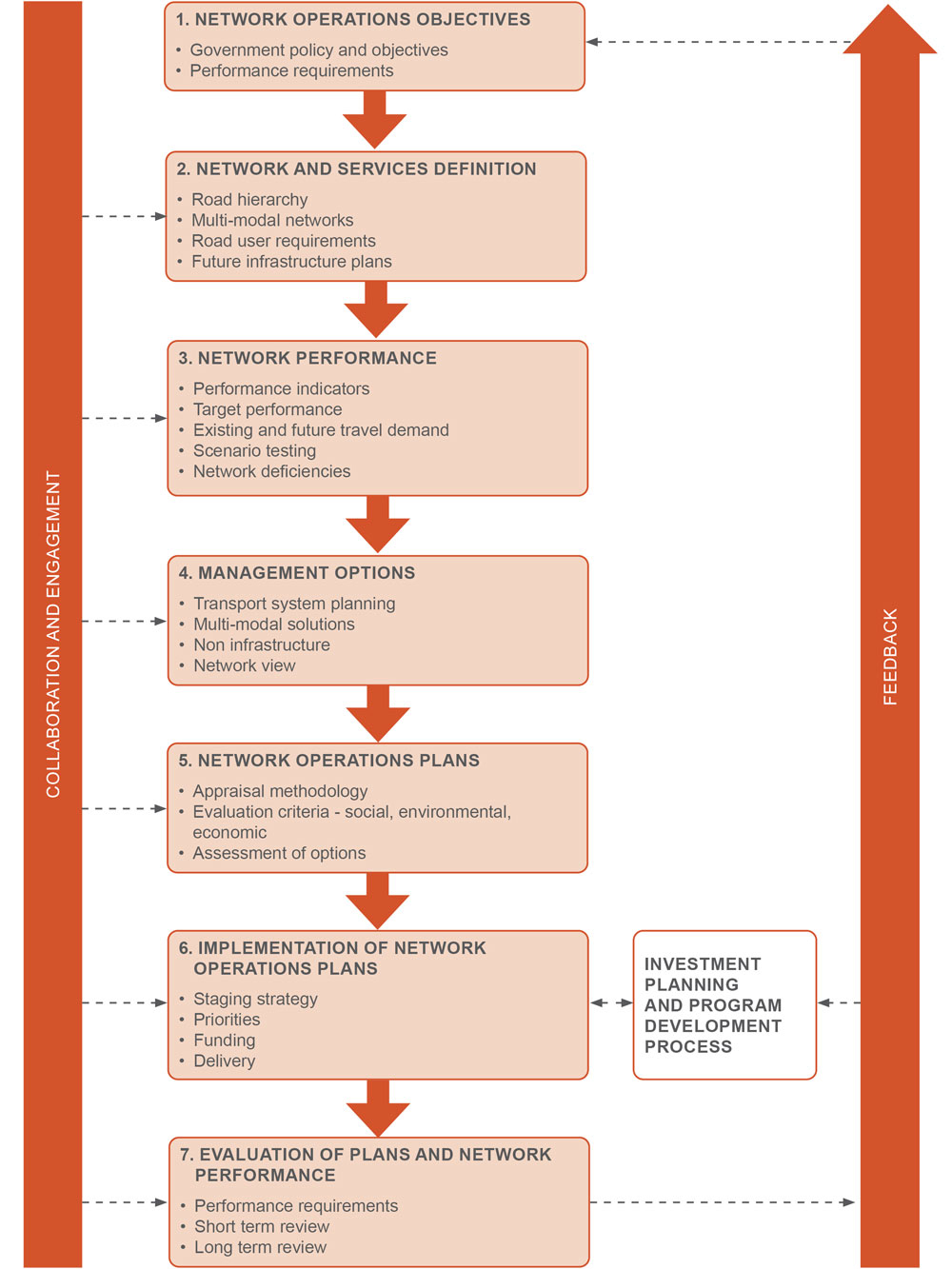Development processes
There is general consistency across jurisdictions in the process to develop a NOP.
Most documented processes to develop a NOP have similar key steps:
- Initiation, scoping and definition of study area
- Development of network / project objectives and performance indicators
- Network performance assessment and gap analysis
- Development of interventions / plans and testing
- Implementation
- Evaluation and feedback.
A common approach is shown below.
Network Operation Planning Framework

The differences in approach between jurisdictions includes: terminology, the breaking down of some of the steps, how much of the process was adopted, and the evaluation and feedback steps.
Source material
Source | NOP development processes / steps / stages |
|---|---|
The Framework is a methodology regarding how to develop and implement a NOP, see Figure 2 p18 (reproduced above). | |
Section 5 - Conclusions and Recommendations p15 indicates that there are a number of changes to the NOP Framework to help it have a greater regard for the following recommended changes to the NOP Framework:
| |
Signal Management Techniques to Support Network Operations (2015) | Section 3.2.1 - Network Operation Planning p6-7 lists the seven phases associated with the NOP Framework from Section 5.1 of the Austroads Guide to Traffic Management Part 4: Network Management Strategies (2020) |
Section 3.1 - Application of LOS Framework in NOP p8-12 and Figure 3.1 p8 sets out the network operation planning process from Section 5.1 of the Austroads Guide to Traffic Management Part 4: Network Management Strategies (2020) | |
Development of the Accessibility-Based Network Operations Planning Framework (2015) | Section 3.2 - Stage of the Accessibility-based NOP Framework p13-14 and Figure 3.2 p14 sets out the approach to developing a NOP. This is based on Section 5.1 of the Austroads Guide to Traffic Management Part 4: Network Management Strategies (2020), but includes an additional phase relates to accessibility-based NOP considerations. |
Guide to Traffic Management Part 4: Network Management Strategies (2020) | Section 5.1 - Network Operation Planning Process p58-59 and Figure 5.3 p59 sets out the network operation planning process, which is based on the proposed NOP planning framework in Austroads Network Operations Planning Framework (AP-R338-09). Main changes relate to Phase 5 and the terms used for Network Operation Plans, i.e. broken into management, operation and improvement plans. |
Section 2.1 - Multiple Network Operation Planning p4-5 and Figure 2.1 p5 sets out the network operation planning process from Section 5.1 of the Austroads Guide to Traffic Management Part 4: Network Management Strategies (2020) |
Source | NOP development processes / steps / stages |
|---|---|
Figure 3.1 p37 and Section 3.2 - Corridor and area planning p41 sets out the following three main activities:
It is also noted that this is part of the broader eight step Transport System Management Framework in Figure 1 p12. | |
Road Network Planning Urban Design ‘Place’ Character Assessment Methodology and Guidance Notes (2019) | Appendix A, Section 3.1 - Project Stages and Figure 11 p15 sets out the following five stages in the development of the Road Network Plans:
|
MRWA Network Operation Planning Framework (2014) | Section 2.1 - Overview of the Proposed NOP Framework and Figure 2.1 p4 sets out the following eight phases in the development of a NOP:
|
Overview of the Framework p11 indicates the following four stages:
| |
The four steps in the framework section and Process Diagram outline the following steps in the NOP development:
| |
Facilitating Network Operations Planning: A Case Study of the VicRoads SmartRoads Framework (2018) | See Figure 1. Diagram. Approach to planning for transportation systems management and operations within corridors or subareas p4
+ Monitor level of operation over time |
A comparative study of four network operations planning frameworks guidelines (2010) | Refined Conceptual Network Operations Planning Process section p18-22 provides the following NOP development phases:
|
Scope of route strategies section p3 states:
"We will complete 18 route strategies, covering all of our roads and building on the approach we took in the first round. Each strategy will cover a key strategic route, providing a description of the key centres of population and industry, and international gateways served by the route, the type of road, its current performance and constraints. We will consider options for maintaining, operating or enhancing roads, including on local roads where these may bring about benefits such as alleviating congestion, on the strategic road network. Where appropriate, this could include influencing driver behaviour, or recommend looking further at other modes of travel. Where an area has a number of route strategies that are all relevant, such as east and west connections and around Birmingham and Leeds, we will ensure the interfaces are addressed." | |
Figure 1. Diagram. Approach to planning for transportation systems management and operations within corridors or subareas p4 sets out the key TSMO steps as follows:
It is noted that there is no one-size-fits-all approach to TSMO planning and implementation; however, proven practices and lessons learned can be applied. |
Source | NOP development processes / steps / stages |
|---|---|
| |
| |
It was noted that the NOP was completed in a staged approach (one quadrant of Hamilton’s network at a time), which they found very beneficial in terms of getting feedback updating and improving their implementation of the subsequent quadrants. | |
| |
Warrigal Road Movement and Place – Intersection Operating Principles | Steps for a Signal Route Review consist of the following:
General process to all NOP activities relates to the following Movement and Place Option Assessment steps:
|
